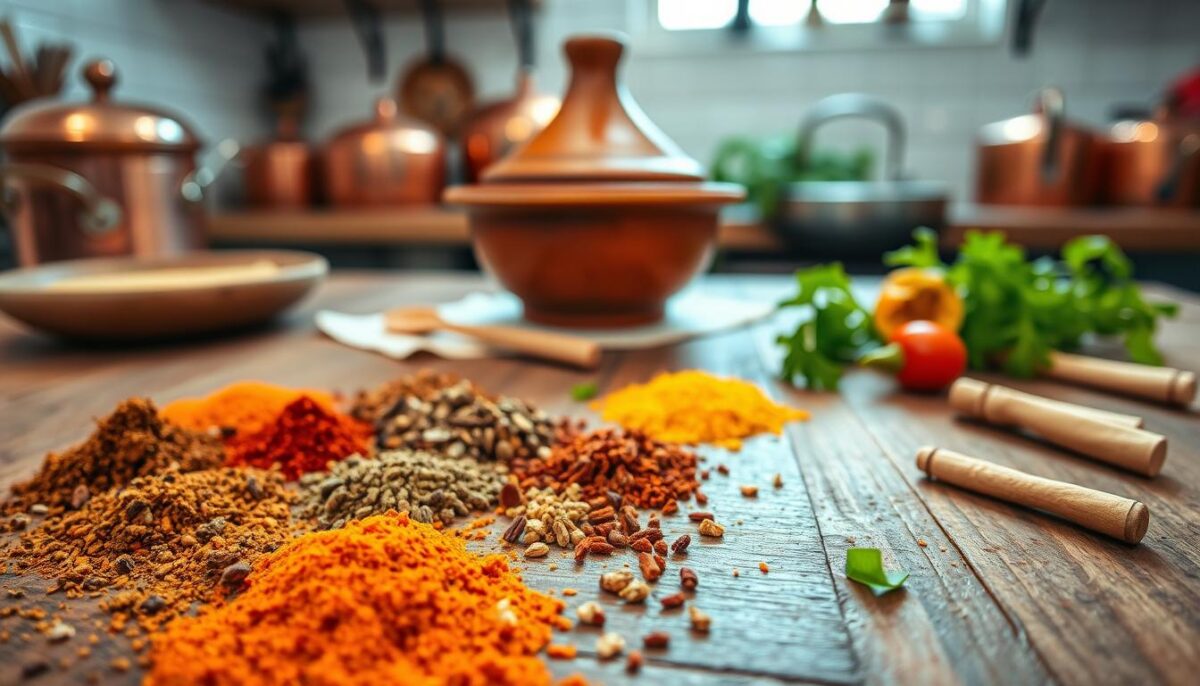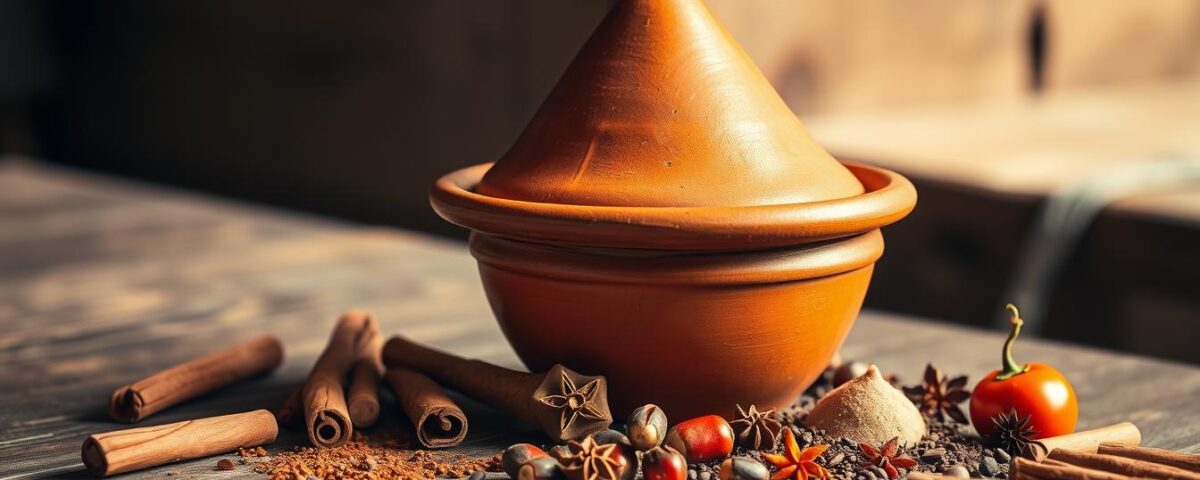
Thai Kitchen Essentials: 7 Dishes That Define Thailand
April 28, 2025
Why You’ll Fall in Love with Lebanese Food (And How to Start Cooking It)
April 28, 2025I still remember the first time I lifted the conical lid of a traditional clay pot, releasing a cloud of aromatic steam that carried whispers of distant markets and sun-soaked landscapes. It wasn’t just dinner—it felt like unlocking a secret. That moment sparked my obsession with mastering the art of slow-cooked meals, where patience becomes the most vital ingredient.
My journey began with a simple gift: a handcrafted clay vessel gifted by a friend who’d traveled to North Africa. At first, I treated it like any other kitchen tool. But as I experimented, I realized its unique shape wasn’t just decorative—it transformed ordinary ingredients into something extraordinary. The gentle heat circulation coaxed tender meats and vegetables into melding with seasonings in ways my Dutch oven never achieved.
What truly captivated me was how a handful of earthy seasonings—warm cinnamon, sharp ginger, and smoky cumin—could create such complexity. I’d add them to stews expecting boldness, only to discover subtle harmonies that made every bite an exploration. Soon, Friday nights became my ritual for testing blends, filling my kitchen with scents that made neighbors linger at my door.
Key Takeaways
- The distinct design of clay cookware enhances flavor through even heat distribution
- Slow cooking unlocks deeper taste profiles in meats and vegetables
- Balancing warm spices creates layers of aroma without overpowering dishes
- Authentic preparation methods connect meals to cultural traditions
- Quality ingredients elevate simple recipes into memorable experiences
Understanding the History and Cultural Roots of Tagine Cooking
Long before modern kitchens, Berber nomads perfected a cooking method that turned simple meals into communal treasures. Their clay pots, shaped like ancient desert dunes, allowed tough cuts of meat to soften in their own juices over smoldering coals. This wasn’t just survival—it was the birth of a culinary legacy.
Origins of the Authentic Cooking Vessel
Archaeologists trace these vessels back nearly 2,000 years, when North African tribes needed portable solutions for harsh environments. The conical lid’s design wasn’t accidental—it condensed steam, recycling moisture into tender results. What began as practical cookware became a cultural icon, evolving alongside trade routes that introduced new ingredients.
More Than Just a Meal
Sharing from the same pot symbolizes trust in many households. I’ve watched families gather around, using bread to scoop savory stews as laughter fills the room. One chef told me, “The time it takes to cook mirrors the care we show our guests.” Recipes passed through generations often hide stories of migration, marriage, and harvest seasons.
Modern kitchens might use faster methods, but I always return to that slow, even heat. It coaxes out flavors that rushed cooking can’t replicate, connecting my suburban stove to windswept Atlas Mountain villages.
Mastering Moroccan Tagine Spice Flavors
The first time I toasted whole coriander seeds, their citrusy fragrance told me I’d been missing half the story. Authentic blends demand more than pre-ground powders—they require engaging all five senses. This discovery changed how I approach every dish.
Identifying Key Components
Earthiness comes from cumin seeds, which I grind fresh to preserve their nutty depth. Ginger adds warm zing, while garlic forms the savory backbone. For brightness, I chop flat-leaf parsley right before cooking—its chlorophyll punch fades fast.

Toasting transforms spices. I dry-roast whole cinnamon sticks and chili pods until they release oils, then crush them. This unlocks smoky sweetness that balances paprika’s subtle fruitiness. Pro tip: Cool toasted spices completely before blending to prevent clumping.
Crafting Harmonious Combinations
The magic happens in ratios. My base mix uses:
- 3 parts cumin (earthy foundation)
- 2 parts ginger (warming spark)
- 1 part chili (controlled heat)
I adjust based on main ingredients—lamb gets extra cinnamon, fish prefers saffron threads. The clay pot’s sealed environment melds these elements beautifully. Last week, a pinch more garlic turned a good chicken dish into something my friends still talk about.
When shopping, I sniff jars before buying. Fresh cumin should smell like toasted nuts, not dust. Crush a coriander seed between your fingers—if it doesn’t burst with citrus, keep looking.
How I Create Delicious Moroccan Tagine Dishes at Home
Last Tuesday, my kitchen timer beeped, signaling another successful experiment in slow-cooked perfection. Through years of testing, I’ve refined techniques that turn weeknight dinners into vibrant experiences—even without specialty equipment.
My Step-by-Step Cooking Process
I start by massaging chicken thighs with olive oil and my signature ras el hanout blend. For deeper flavor, I let lamb shoulder soak overnight in garlicky marinade. The real magic happens when layering ingredients: root vegetables cushion meats, while preserved lemons add bright punches.
Low heat is non-negotiable. I keep my clay pot simmering at 275°F—hot enough to tenderize connective tissue without drying proteins. Last month, I discovered adding broth in three stages prevents scorching while building rich sauces.
Innovative Protein Variations
Fish stews taught me about timing. Delicate cod needs just 20 minutes, so I sear it first for texture. For chicken dishes, I brown skin-side up before adding olives. My favorite twist? Grilling lamb cubes briefly before stewing adds smoky complexity.
No traditional pot? Use a Dutch oven with foil under the lid. The key lies in balancing moisture and spice ratios. As my neighbor joked last week, “Your kitchen smells like Marrakech—but your cleanup time says suburban mom.”
Creative Culinary Uses for My Moroccan Tagine Spice Mix
Last summer, I discovered my secret weapon could transform even basic weeknight meals into global adventures. While the clay pot remains my favorite tool, the real magic lies in the aromatic blend itself—a passport to bold flavors beyond traditional preparations.

Marinades, Grilling, and Stew Enhancements
I now rub the mix onto salmon fillets before pan-searing—the cumin and ginger create a caramelized crust that pairs perfectly with mango salsa. For grilled veggies, I whisk it into olive oil with minced garlic. Pro tip: Add a teaspoon to burger patties for depth that surprises every backyard BBQ guest.
My biggest revelation? Stirring a tablespoon into lentil stew during the last simmer. The spices bloom beautifully, adding warmth without overpowering earthy legumes. A friend recently texted: “Used your blend in chili—total game-changer!”
Elevating Couscous and Other Traditional Dishes
Instead of plain couscous, I toast the grains with the mix before steaming. Chopped mint and toasted almonds complete the upgrade. The same approach works wonders on roasted carrots or cauliflower—toss with oil and a generous pinch before baking.
I’ve even blended it into hummus for smoky dips, and last month, sprinkled it over avocado toast with lemon zest. The key lies in balancing boldness: pair with fresh cilantro or parsley to brighten rich flavors. Why not shake some into your next Bloody Mary rim?
This journey taught me that great blends adapt. Whether enhancing global recipes or reinventing classics, creativity unlocks endless possibilities—one pinch at a time.
Conclusion
When I first stirred my homemade blend into a simmering pot, I realized every pinch tells a story. Through years of testing ratios and techniques, I’ve learned that balance defines great dishes—whether crafting lamb stews or brightening grilled chicken. The right mix transforms simple ingredients into layered experiences, where earthy cumin dances with citrusy coriander.
Don’t limit these blends to traditional pots. Try rubbing them on fish before searing, or toss roasted veggies with a bold sprinkle. My go-to move? Stirring a teaspoon into lentil soups during the final simmer. These small tweaks create depth without overpowering natural flavors.
What excites me most is how these methods bridge cultures. A well-balanced marinade can turn Tuesday’s dinner into a global adventure. I encourage you to play with heat levels and fresh herbs—maybe add chili for warmth or parsley for freshness. Share your creations, swap stories, and let your kitchen become a passport to new tastes.
Thank you for joining this journey. Remember: great cooking isn’t about perfection. It’s about curiosity, quality ingredients, and the joy of discovery. Now grab that Dutch oven and start blending—your next masterpiece awaits.
FAQ
Can I substitute fresh herbs for dried ones in my spice blend?
I prefer using dried herbs like parsley or cilantro in my mix because they’re shelf-stable, but fresh herbs add brightness. Just adjust quantities—use three times more fresh than dried to avoid overpowering other flavors.
What’s the best way to balance heat in dishes like stews or grilled meats?
Start with a pinch of chili or paprika and taste as you cook. I add a touch of sweetness—like honey or cinnamon—to mellow the heat while letting cumin and ginger shine through.
How do I use this seasoning on fish without overwhelming it?
Fish loves gentle flavors! I mix a little garlic and coriander into the blend, then rub it lightly with olive oil. For lighter dishes, skip the chili and let lemon zest brighten the marinade.
Can I cook a tagine-style dish without the traditional clay pot?
Absolutely! I use a heavy Dutch oven or slow cooker. Just keep the lid tight to trap steam, and layer ingredients as you would in a clay pot—meats first, then veggies, herbs, and spices on top.
What’s your go-to method for pairing couscous with bold flavors?
I toss cooked couscous with a drizzle of olive oil, toasted almonds, and a sprinkle of my spice mix. For extra depth, stir in roasted veggies or raisins to complement savory or sweet notes in the main dish.



